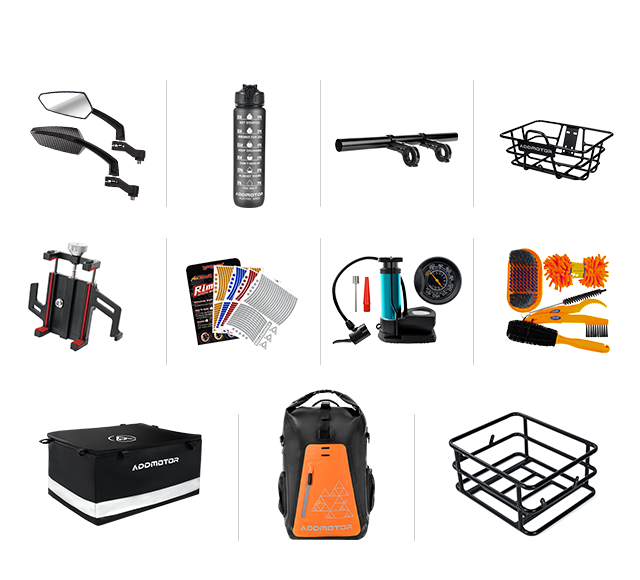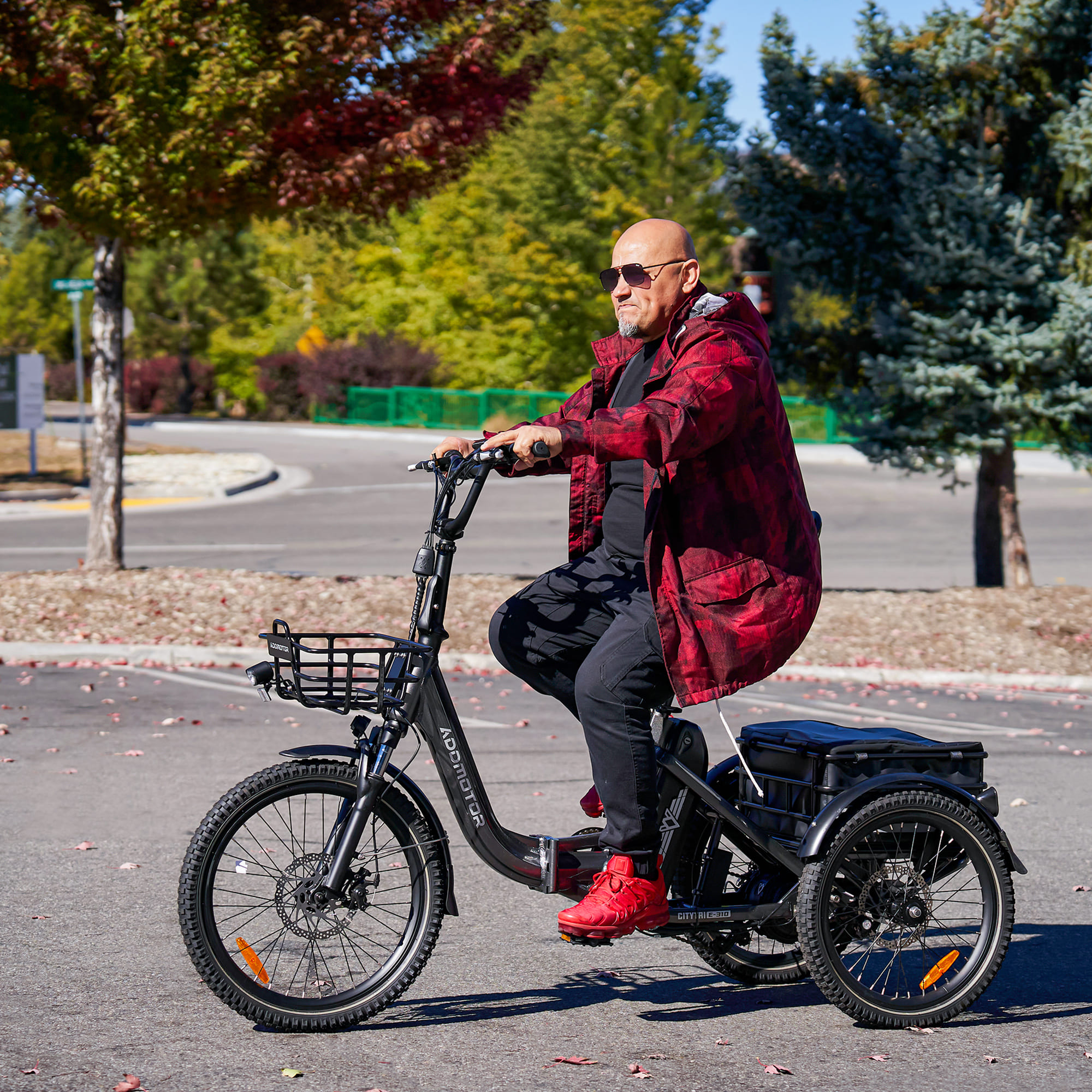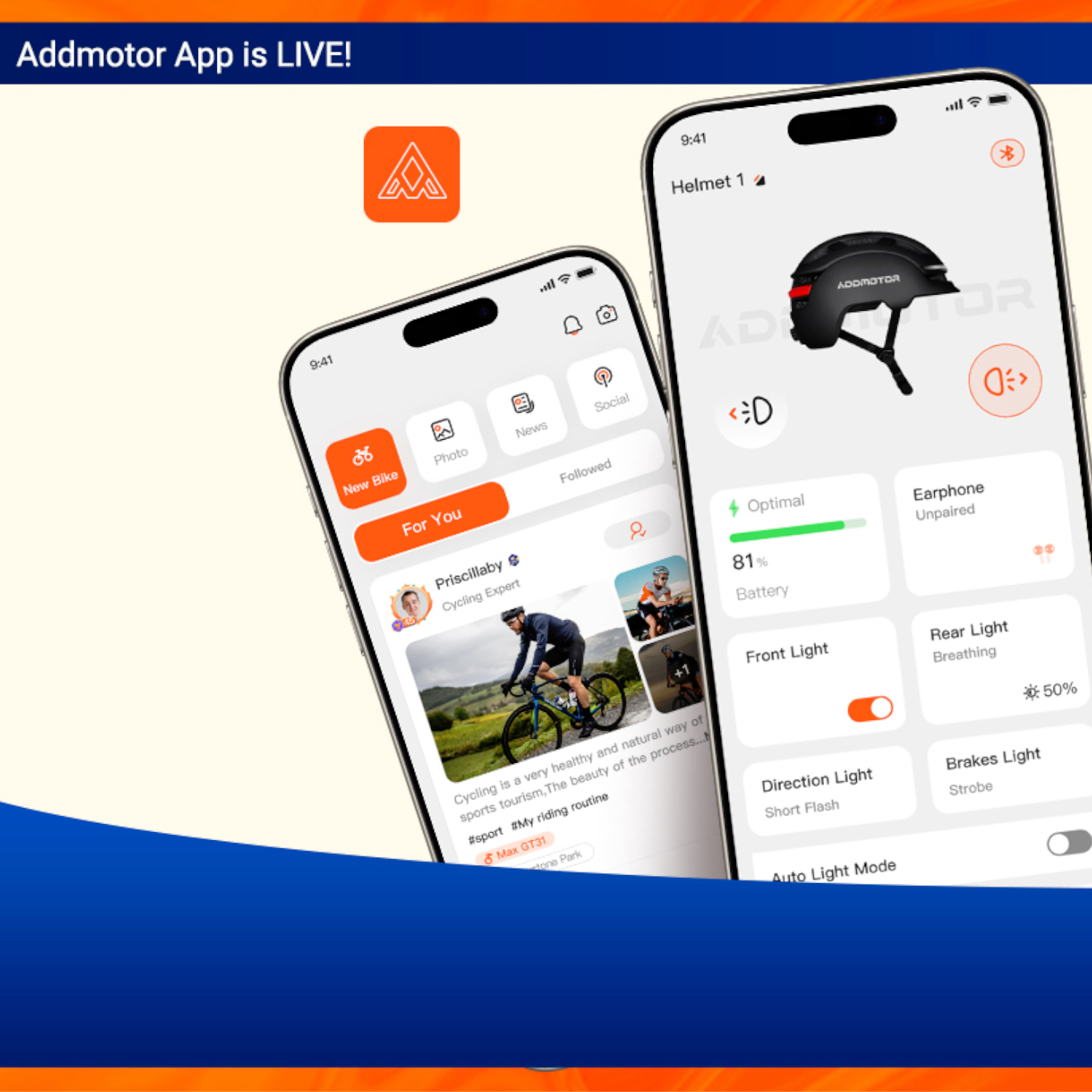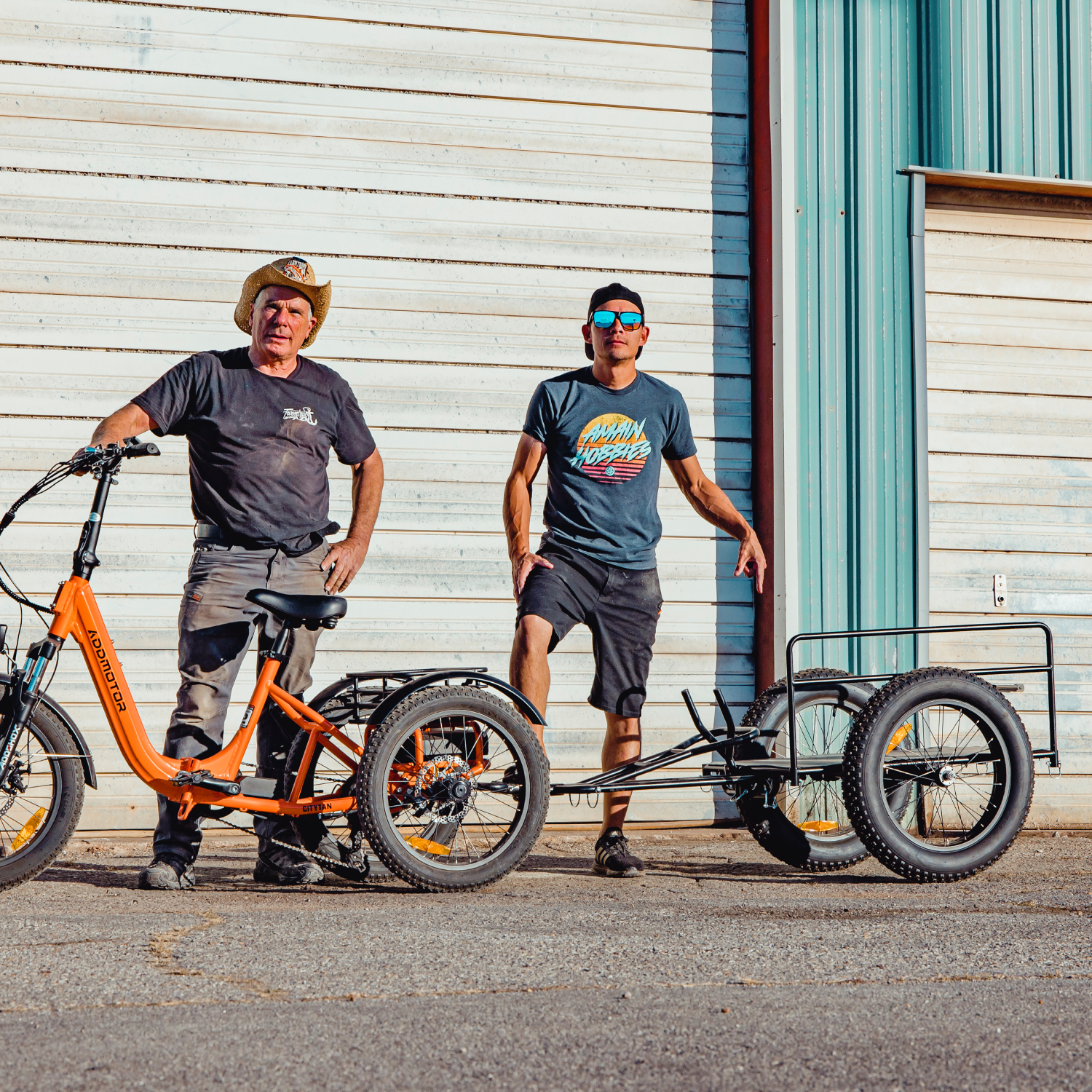ADDTECH | E-Bike Mechanical Components: The Gearing System
By Addmotor | 29 March 2024 | 0 Comments
A quick search on electric bikes will make you realize that most of the information and advice focuses around how powerful the motor is or how long the battery lasts. But there’s one important part that doesn’t get as much attention: the e-bike gearing system.
Gears help you ride comfortably over different kinds of terrains. For example, you wouldn’t use the same gear to ride on a flat road as climbing a steep hill. E-bike gears have different assist levels that make pedaling easier or harder, depending on what you need.
Using gears correctly means you, your e-bike’s battery, and its motor can all work better together. This not only makes your ride smoother but also helps the battery last longer and the motor work more efficiently.
This guide will cover everything you need to know about the e-bike gearing system and what gear options you have on a standard adult electric bike.
Larger chainrings require more force to turn, but they propel the bike faster, while smaller chainrings make pedaling easier, especially on uphill climbs.
Derailleur gears, characterized by their external sprocket assembly and moving derailleur, are widely used for their versatility and wide range of gears. Alternatively, hub gears present a sleek, enclosed option within the rear hub. They stand out for their aesthetic appeal and reduced maintenance needs, offering a straightforward and reliable shifting experience.
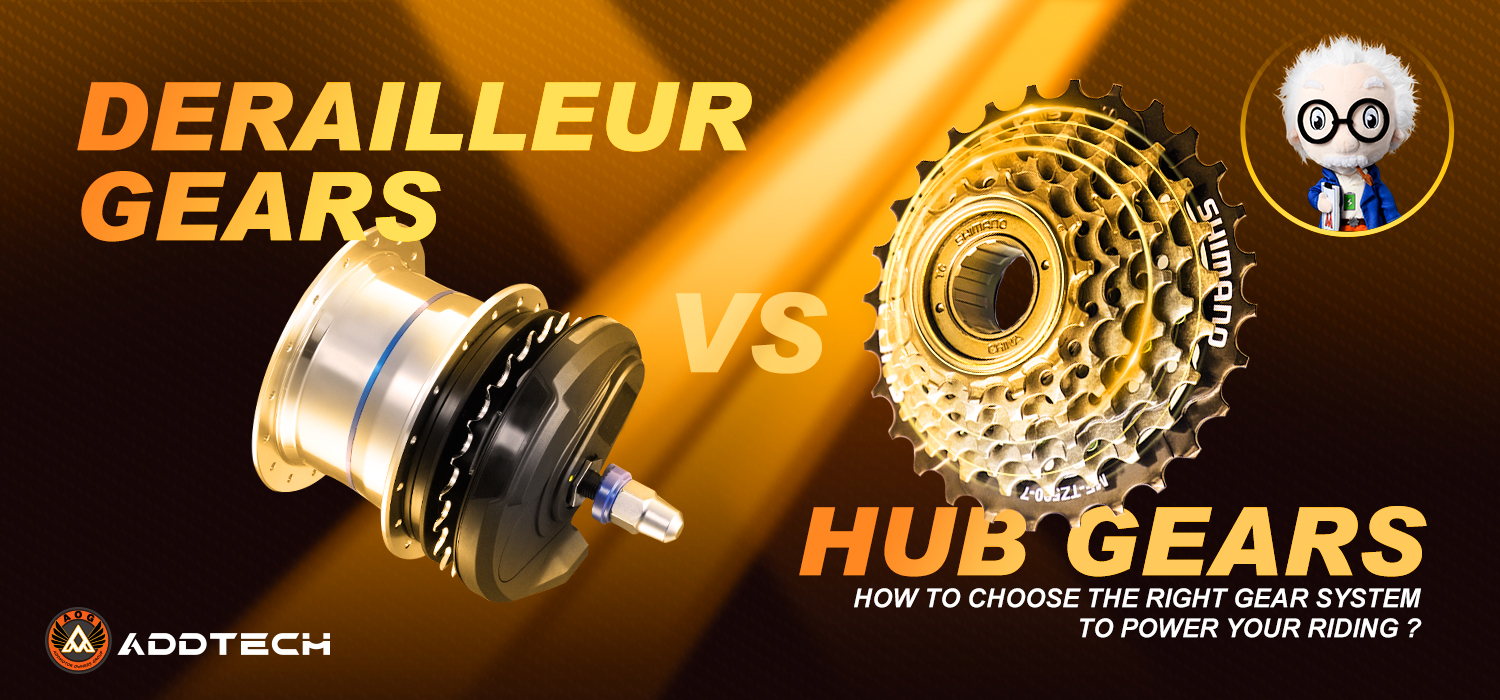
The choice between derailleur gears and hub gears shapes not only the aesthetic of the e-bike but also its performance, maintenance needs, and overall riding experience. Both systems cater to different rider preferences and conditions with unique advantages and considerations.
The primary advantage of derailleur gears lies in their lightweight construction and the ability to offer more gear combinations, which can significantly enhance the bike’s versatility and performance. They are also cheap, so it’s easy to replace them if they are damaged.
However, the external positioning of the derailleur system makes it more vulnerable to damage from external elements, such as mud, dirt, and debris, potentially leading to more frequent maintenance and adjustments. Moreover, the reliance on a physical chain movement means that shifting gears is most efficient when the bike is in motion and under less pedal pressure, requiring a bit of foresight and skill from the rider to execute smooth gear changes.
Hub gears typically provide a seamless and straightforward shifting experience, making them ideal for those who prioritize convenience and minimal maintenance.
While hub gears usually offer fewer gear ratios than their derailleur counterparts, they provide a sufficient range for most urban and leisure riding scenarios. The trade-off for their robustness and ease of use is a slightly heavier weight and, in some cases, a more complex internal structure, which can make servicing more complicated and potentially costlier.
Riders looking for high performance and a wide range of gear ratios who don’t mind the extra maintenance might lean towards derailleur gears. Alternatively, those who value simplicity, reliability, and ease of use, particularly in urban environments, may find hub gears more appealing.
But how many gears do you actually need on your e-bike?
Let’s discuss the range of gear options typically found in standard electric bikes to help you make an informed decision.
This minimalist setup offers a straightforward riding experience, ideal for flat urban environments where complex gear systems are unnecessary. Riders may apply the same level of pedaling effort with the single-speed gear ratio.
The lack of multiple gears reduces maintenance needs and potential mechanical issues, making single-speed e-bikes a durable and cost-effective option. However, it’s worth noting that relying on a single gear may limit your efficiency and comfort on varying terrains, especially when facing steep inclines or needing to accelerate quickly.
The 7-speed setup strikes a balance between the simplicity of fewer gears and the adaptability of a wider gear range. The seven-gear ratios determine the relationship between the rotation of the pedals and rear wheel, impacting the ease and difficulty of pedaling and the bike’s speed.
This gear option is well-suited for riders who encounter mixed terrain in their daily commutes or leisure rides. It provides enough flexibility to adjust the pedaling force for navigating gentle slopes and urban environments. This not only reduces fatigue over longer distances but also increases the enjoyment and efficiency of the ride.
Compared to more complex gearing systems, the 7-speed setup is relatively straightforward, reducing lower maintenance requirements. Its design is robust enough to withstand daily use across different environments and deliver reliable performance over time.
The 9-speed gear option is ideally suited for adventurous off-road trails and bustling urban environments. It accommodates the needs of riders who require a gear system that can adapt to the unpredictable nature of outdoor exploration as well as the structured demands of city cycling.
The only downside is that it weighs slightly more than the single-speed and seven-speed systems because of the additional components.
Next, think about how you like to ride. Do you prefer a leisurely pace with minimal fuss over gear changes, or do you enjoy the control and flexibility of adjusting your gear to match your riding conditions precisely?
The intended use of your e-bike can also influence your choice. For instance, if you’re using the e-bike for daily commuting in a city, ease of use and durability may be your top priorities, pointing towards a hub gear system. On the other hand, if you’re using the e-bike for recreational purposes across varied landscapes, a derailleur system with a wider gear range might be more appropriate.
Also, don’t forget that hub gears generally require low upkeep due to their enclosed design, while derailleur systems need more frequent maintenance.
Whether you’re a daily commuter or an off-road adventurer, taking the time to understand and select the appropriate gearing system will ensure that your e-bike journey is as smooth, controlled, and enjoyable as possible. Make sure you take the time to understand your needs and preferences before choosing the best gearing system for your e-bike.
Gears help you ride comfortably over different kinds of terrains. For example, you wouldn’t use the same gear to ride on a flat road as climbing a steep hill. E-bike gears have different assist levels that make pedaling easier or harder, depending on what you need.
Using gears correctly means you, your e-bike’s battery, and its motor can all work better together. This not only makes your ride smoother but also helps the battery last longer and the motor work more efficiently.
This guide will cover everything you need to know about the e-bike gearing system and what gear options you have on a standard adult electric bike.
The Basics of the E-Bike Gearing System
The e-bike gearing system consists of several parts that work harmoniously to make your ride smooth and comfortable. Here is an overview of each component:Chain:
The chain is the central part of the gearing system that transfers power from the motor to the rear wheel. This propels the bike forward, transforming electrical energy into mechanical motion.Chainrings:
The chainrings are positioned at the forefront of the gear system and are attached directly to the pedal crank arm. They come in various sizes and play a key role in determining the bike’s speed and the effort required to pedal.Larger chainrings require more force to turn, but they propel the bike faster, while smaller chainrings make pedaling easier, especially on uphill climbs.
Derailleur:
This mechanism guides the chain from one sprocket to the next on the cassette. It’s controlled by the shifter to enable riders to switch gears in response to different riding conditions.Shifter:
The shifter is the command center for gear selection, mounted with precision on the handlebars. With a simple flick, riders can engage the desired gear thanks to a direct connection to the derailleur. This connection may be mechanical, involving a physical cable, or electronic in more advanced setups.Gear Types:
Adult electric bikes have different gearing systems, each with unique advantages.Derailleur gears, characterized by their external sprocket assembly and moving derailleur, are widely used for their versatility and wide range of gears. Alternatively, hub gears present a sleek, enclosed option within the rear hub. They stand out for their aesthetic appeal and reduced maintenance needs, offering a straightforward and reliable shifting experience.
Derailleur Gears vs. Hub Gears

The choice between derailleur gears and hub gears shapes not only the aesthetic of the e-bike but also its performance, maintenance needs, and overall riding experience. Both systems cater to different rider preferences and conditions with unique advantages and considerations.
Derailleur Gears
Derailleur gears, a common sight in both traditional and electric bikes, operate through a mechanism that moves the chain across a set of exposed sprockets or gears at the rear wheel and potentially the front. This system allows for a wide range of gear ratios, enabling riders to fine-tune their pedaling effort according to the terrain, be it climbing steep hills or cruising on flat roads.The primary advantage of derailleur gears lies in their lightweight construction and the ability to offer more gear combinations, which can significantly enhance the bike’s versatility and performance. They are also cheap, so it’s easy to replace them if they are damaged.
However, the external positioning of the derailleur system makes it more vulnerable to damage from external elements, such as mud, dirt, and debris, potentially leading to more frequent maintenance and adjustments. Moreover, the reliance on a physical chain movement means that shifting gears is most efficient when the bike is in motion and under less pedal pressure, requiring a bit of foresight and skill from the rider to execute smooth gear changes.
Hub Gears
Hub gears represent a more contained system, where the gearing mechanism is enclosed within the rear hub. This design protects the gears from environmental factors, leading to lower maintenance and a cleaner look. It also allows for gear changes at a standstill, offering a significant advantage in urban settings or stop-start riding conditions.Hub gears typically provide a seamless and straightforward shifting experience, making them ideal for those who prioritize convenience and minimal maintenance.
While hub gears usually offer fewer gear ratios than their derailleur counterparts, they provide a sufficient range for most urban and leisure riding scenarios. The trade-off for their robustness and ease of use is a slightly heavier weight and, in some cases, a more complex internal structure, which can make servicing more complicated and potentially costlier.
Choosing Between Derailleur and Hub Gears
The choice between derailleur and hub gears boils down to personal preference, riding style, and the conditions in which the e-bike will be primarily used.Riders looking for high performance and a wide range of gear ratios who don’t mind the extra maintenance might lean towards derailleur gears. Alternatively, those who value simplicity, reliability, and ease of use, particularly in urban environments, may find hub gears more appealing.
Exploring the Range of Gear Options in Standard Electric Bikes: How Many Gears Do You Need on Your E-Bike Gearing System?
Whether cruising through city streets or tackling rugged terrain, the number of gears on your e-bike can significantly influence your comfort, control, and overall satisfaction.But how many gears do you actually need on your e-bike?
Let’s discuss the range of gear options typically found in standard electric bikes to help you make an informed decision.
Single-Speed
A single-speed e-bike embodies simplicity and ease of use. With only one gear, the bike is devoid of gear shifters, derailleurs, and the multiple sprockets found on its multi-speed counterparts.This minimalist setup offers a straightforward riding experience, ideal for flat urban environments where complex gear systems are unnecessary. Riders may apply the same level of pedaling effort with the single-speed gear ratio.
The lack of multiple gears reduces maintenance needs and potential mechanical issues, making single-speed e-bikes a durable and cost-effective option. However, it’s worth noting that relying on a single gear may limit your efficiency and comfort on varying terrains, especially when facing steep inclines or needing to accelerate quickly.
7-Speed
Stepping up to a 7-speed e-bike introduces a broader spectrum of versatility. With seven gears at your disposal, you can more easily adapt to different terrains and inclines and enjoy a smoother ride across a variety of landscapes.The 7-speed setup strikes a balance between the simplicity of fewer gears and the adaptability of a wider gear range. The seven-gear ratios determine the relationship between the rotation of the pedals and rear wheel, impacting the ease and difficulty of pedaling and the bike’s speed.
This gear option is well-suited for riders who encounter mixed terrain in their daily commutes or leisure rides. It provides enough flexibility to adjust the pedaling force for navigating gentle slopes and urban environments. This not only reduces fatigue over longer distances but also increases the enjoyment and efficiency of the ride.
Compared to more complex gearing systems, the 7-speed setup is relatively straightforward, reducing lower maintenance requirements. Its design is robust enough to withstand daily use across different environments and deliver reliable performance over time.
9-Speed
The 9-speed gear option on electric bikes is designed for riders who demand greater versatility and precision in their cycling experience. It is achieved by having an extra sprocket (or cog) on the rear hub. The 9-speed system is engineered for seamless gear transitions, enabling riders to quickly and precisely adjust their pedaling effort to navigate steep inclines, rapid descents, and extended flat stretches with ease. This results in a more enjoyable ride, with less effort wasted on struggling to find the correct gear. Whether adjusting for sudden changes in terrain or optimizing cadence for energy efficiency, riders can expect a responsive and reliable shifting experience.The 9-speed gear option is ideally suited for adventurous off-road trails and bustling urban environments. It accommodates the needs of riders who require a gear system that can adapt to the unpredictable nature of outdoor exploration as well as the structured demands of city cycling.
The only downside is that it weighs slightly more than the single-speed and seven-speed systems because of the additional components.
FAQs about the Electric Bike Gearing System
Below, we address some of the most frequently asked questions about e-bike gearing systems to help you make the most of your ride.1. Is there a gear system in electric bikes?
Yes, most electric bikes come equipped with a gear system. These gears function similarly to those on traditional bicycles, allowing riders to adjust their pedaling effort according to the terrain or their personal preference for enhanced efficiency and comfort.2. What is the best gearing system for an electric bike?
The “best” gearing system for an e-bike depends largely on your riding needs and environment. A single-speed or lower gear range might suffice for city commuters or those riding on mostly flat terrains. However, for riders tackling varied terrains or steep inclines, a multi-speed system, such as 7-speed or 9-speed, offers greater versatility and control.3. What is the gear ratio of an electric bike?
The gear ratio of an e-bike refers to the relationship between the number of teeth on the front chainring(s) and the rear cog(s). This ratio affects how easy or hard it is to pedal at different speeds. Adult electric bikes have various gear ratios designed to optimize performance across riding conditions. Generally, a 300% gear ratio is considered appropriate for multiple terrains.4. What are the different types of gears on e-bikes?
E-bikes typically feature two main types of gear systems: derailleur gears and hub gears. Derailleur gears are more common and involve a chain shifting across various sprockets. On the other hand, hub gears are contained within the rear hub and offer a streamlined look with reduced maintenance needs.5. Do e-bikes change gears automatically?
Some electric bikes are equipped with automatic gear systems that adjust the gears based on the rider’s speed, pedal power, or terrain to ensure an effortless riding experience. However, most e-bikes still rely on manual gear shifting, where the rider controls gear changes using a handlebar-mounted shifter.6. How do you use gears on an electric bike?
Using gears on an e-bike is similar to a traditional bike but with the added benefit of electric assist. To shift gears, use the shifter on your handlebars, ideally when pedaling lightly. This helps in a smooth transition and reduces strain on the chain. Begin with lower gears when starting off or climbing hills, and shift to higher gears as you gain speed. Balancing gear use with the electric assist levels can maximize your efficiency and the battery life of your e-bike.7. How do you choose the best gearing system for your e-bike?
First and foremost, consider the types of terrain you’ll frequently encounter. A single-speed gear system might be sufficient if your rides are mainly on flat urban streets. However, if you anticipate climbing steep hills or traversing diverse terrains, a more complex system with a wider range of gears, like a 7-speed or 9-speed, would offer better adaptability and control.Next, think about how you like to ride. Do you prefer a leisurely pace with minimal fuss over gear changes, or do you enjoy the control and flexibility of adjusting your gear to match your riding conditions precisely?
The intended use of your e-bike can also influence your choice. For instance, if you’re using the e-bike for daily commuting in a city, ease of use and durability may be your top priorities, pointing towards a hub gear system. On the other hand, if you’re using the e-bike for recreational purposes across varied landscapes, a derailleur system with a wider gear range might be more appropriate.
Also, don’t forget that hub gears generally require low upkeep due to their enclosed design, while derailleur systems need more frequent maintenance.
Conclusion
As e-bikes continue to evolve, the integration of advanced gearing systems promises to make electric cycling even more enjoyable and efficient.Whether you’re a daily commuter or an off-road adventurer, taking the time to understand and select the appropriate gearing system will ensure that your e-bike journey is as smooth, controlled, and enjoyable as possible. Make sure you take the time to understand your needs and preferences before choosing the best gearing system for your e-bike.
Leave a Reply
Your email address will not be published.Required fields are marked. *
Latest Stories

